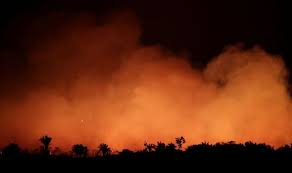Amazon Fires at a Tipping Point for health of the Rainforest

The fires tearing through the Amazon represent a “tipping point” for the health of the rainforest, the head of a top global forestry management body said on 28 August, urging the world to do more to save the trees.
Daily Current Affairs Quiz 2019
The situation in the Amazon is “very urgent,” stressed Gerhard Dieterle, executive director of the International Tropical Timber Organisation, an intergovernmental agency group that promotes sustainable forestry use.
“This is something that might affect the integrity of the Amazon as a whole, because if the forest fires spread, the grasslands become more prone to forest fires,” Dieterle told AFP on the sidelines of a conference on African development.
“Many experts fear it may be a tipping point” for the rainforest, as the latest figures show a total of more than 82,000 fires blazing in Brazil, even as military aircraft and troops help battle them.
More than half of the fires are in the massive Amazon basin.
Some of the blazes are down to natural causes, Dieterle said, but they are mostly started deliberately by farmers clearing land for agriculture.
“If tropical dense forests are affected by forest fires, they need many, many years to regroup. It will alter the climate, the local climate, the national climate and the regional climate. It will also have an influence on the global climate,” said the forestry expert.
Asked about the G7’s $20 million pledge to combat the flames, Dieterle said it was “a beginning but much more is needed.”
“This is the national sovereignty of Brazil… if they ask for funding, I think the world might be willing to provide more resources,” he said.
Why is the Amazon burning?
An unprecedented number of fires have raged throughout Brazil in 2019, intensifying in August. There have been more than 74,000 fires so far this year, the most ever recorded by the country’s National Institute for Space Research (INPE). It’s a roughly 80 percent jump compared to the number of fires the country experienced over the same time period in 2018. More than half of those fires are taking place in the Amazon.
Why is this a big deal?
Everyone on the planet benefits from the health of the Amazon. As its trees take in carbon dioxide and release oxygen, the Amazon plays a huge role in pulling planet-warming greenhouse gases out of the atmosphere. Without it, climate change speeds up. But as the world’s largest rainforest is eaten away by logging, mining, and agribusiness, it may not be able to provide the same buffer.
Why is this a hot topic politically?
When Jair Bolsonaro was campaigning for office as a far-right candidate, he called for setting aside less land in the Amazon for indigenous tribes and preservation, and instead making it easier for industry to come into the rainforest. Since his election in October 2018, Bolsonaro put the Ministry of Agriculture in charge of the demarcation of indigenous territories instead of the Justice Ministry, essentially “letting the fox take over the chicken coop,” according to one lawmaker. His policies have been politically popular among industry and agricultural interests in Brazil, even as they’ve been condemned by Brazilian environmental groups and opposition lawmakers. Hundreds of indigenous women stormed the country’s capital on August 13th to protest Bolsonaro’s environmental rollbacks and encroachment of development on indigenous lands.
How are the fires being fought?
On August 24th, after weeks of international and internal pressure, Bolsonaro deployed the military to help battle the fires, sending 44,000 troops to six states. Reuters reported the next day that warplanes were dousing flames.